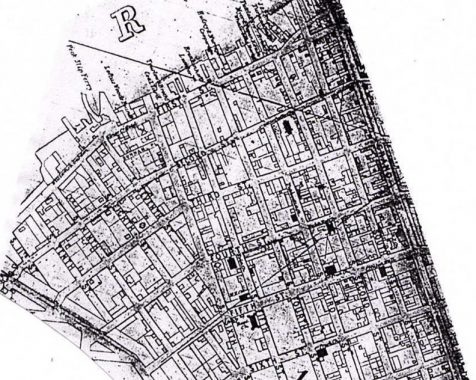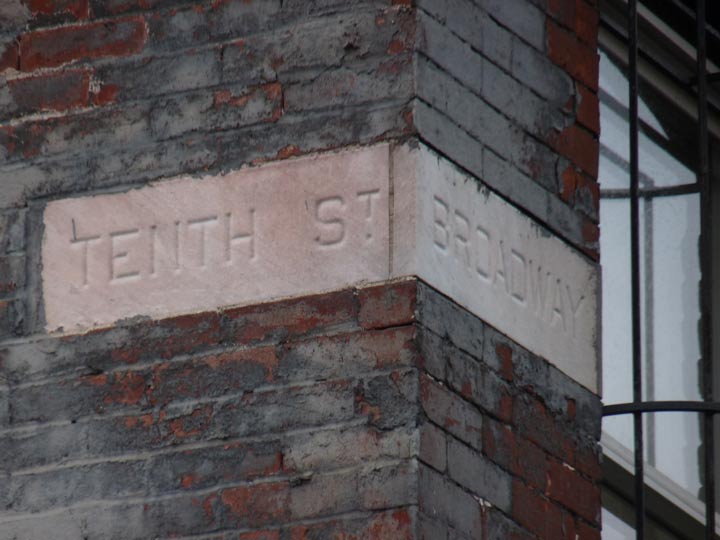
10th and Broadway in Williamsburg? You might think these signs would be found in the Union Square area, where East 10th and Broadway do intersect (at Grace Church, one of the more gorgeous representatives of the species in NYC). If we’re restricting ourselves to Brooklyn, Broadway runs through Bedford Stuyvesant and Bushwick for the most part, while 10th Street is in Park Slope. So what’s going on here?

North-south Williamsburg streets were originally numbered beginning at the East River: thus, Kent Avenue = 1st Street; Wythe = 2nd; Berry = 3rd; Bedford = 4th; Driggs = 5th; Roebling = 6th; Havemeyer = 7th; Marcy = 8th; Rodney = 9th; Keap = 10th; Hooper = 11th; and Hewes = 12th. I can’t pinpoint the date in which the streets gained their current names but the switch was made by 1890. Several buildings over a century old are still standing, and many still carry the old number names on various chiseled signage.
As stated, 10th Street is now called Keap. In Williamsburg and Bedford-Stuyvesant, a number of streets are named for various signers of the Declaration of Independence…
Not every signer is represented, but most are. Ben Franklin, George Clymer, George Taylor, James Wilson, John Morton, and George Ross of Pennsylvania; Caesar Rodney of Delaware; William Hooper, George Hewes and John Penn of North Carolina; Edward Rutledge, Thomas Heyward Jr., Thomas Lynch Jr., and Arthur Middleton of South Carolina; George Walton of Georgia; Elbridge Gerry of Massachusetts; Josiah Bartlett, Matthew Thornton and William Whipple of New Hampshire; Stephen Hopkins and William Ellery of Rhode Island; Richard Stockton and John Hart of New Jersey; George Wythe, Richard Henry Lee (or Francis Lightfoot Lee), and Benjamin Harrison of Virginia… all have named streets in Williamsburg or Bedford-Stuyvesant named for them. John Adams, John Hancock, Francis Lewis, Thomas Jefferson, and Charles Carroll have named streets in other Brooklyn neighborhoods.
Some are missing: Rush Street (Benjamin Rush of Pennsylvania) was lost to urban renewal in the 1970s…Gwinnett Street (Button Gwinnett of Georgia) was absorbed by Lorimer Street in the 1800s; and then there’s McKean Street, named for Thomas McKean of Pennsylvania…
Of course, there never was a McKean Street. The street is actually named Keap Street; a long-ago administrator or mapmaker mistook a handwritten transcription as being “Thomas M. Keap”, and not being a student of history (to be fair, can you name more than five signers of the Declaration?) misnamed the street, which has never been renamed.
If we further look at the 1850 Dripps map, we can see that South 7th Street is no longer on the current map; it’s now a western extension of Broadway. Then as now, Grand Street serves as a buffer between North and South numbered streets. A close look reveals Dunham Place, which was on the map in 1850 and is still there today.
Check out the ForgottenBook, take a look at the gift shop, and as always, “comment…as you see fit.”
2/3/21


4 comments
The Brooklyn Daily Eagle for March 9, 1847 on page 2, column 4, contains a reference to Keap Street (and Rush Street as well) as part of a notice about a permanent water line.
According to Eugene Armbruster, the historian of Brooklyn’s Eastern District, the numbered streets bit the dust in 1889.
A few years ago I visited a museum in San Francisco that has a collection of the signers of the Declaration of Independence, including McKean’s. The small “c” does look like a dot, though the “n” does not clearly resemble a “p”. (I have no idea how this exhibit is located in San Francisco.)
The Declaration of Independence signers’ streets were named by the City of Brooklyn in the early 1850’s – just before Williamsburg and Bushwick were annexed into it. At the time the area now in Williamsburg that is situated below Division St., which was the City line, was known as North Brooklyn. When the numbered streets of Williamsburg were changed, Whyte, Hooper, Hewes and Keap Streets were extended northward.
BTW, Declaration signers streets were also named in Red Hook and Brownsville. These were, in the 1850’s, situated at the extremities of the City of Brooklyn and the City fathers needed to find names for these newly developing streets.
Williamsburg’s numbered streets were initially allowed to remain unchanged after the 1855 annexation of the City of Williamsburgh and the Town of Bushwick. (which included Greenpoint, Bushwick, East Williamsburg, basically all of Brooklyn northeast of Division Avenue and Broadway) This area was dubbed the “Eastern District”, and duplication of street names was gotten around by including “Eastern District”, or “E. D.” as part of the address, in order to differentiate street names and locations. By the 1880s the area was beginning to be considered as “just Brooklyn”, and the duplication of street names had to be dealt with. In 1885 the City of Brooklyn renamed Williamsburg’s First through Twelfth Streets, to be effective 12/1/1885. The “North” and “South” numbered streets were allowed to remain.
Two more Signers: Roger Sherman (CT), Sherman Street; and Carter Braxton (VA), Braxton Street, now Windsor Place.
Thanks for a most interesting article.